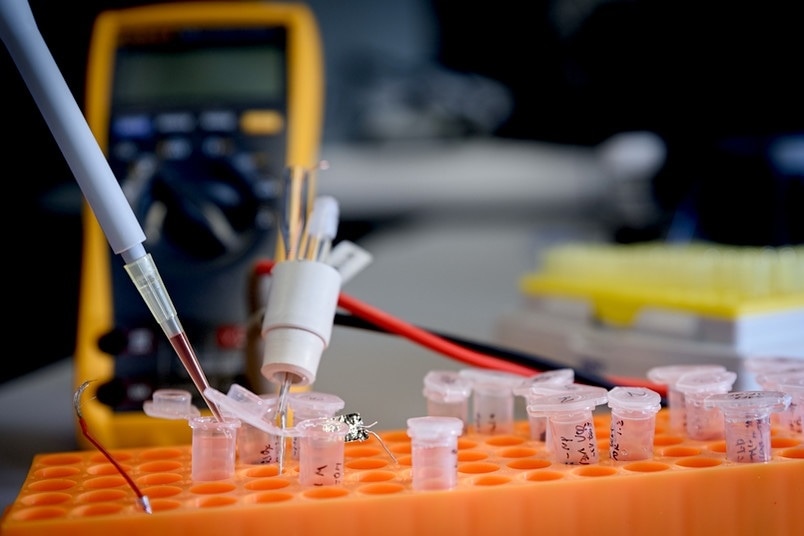Feb 28 2019
An innovative technique has been recently developed by researchers to study the behavior of silver nanoparticles in natural waters. This breakthrough was made by a research team from the Resolv Cluster of Excellence at Ruhr-Universität Bochum.
 A Bochum research team has developed a spectro-electrochemical method in order to characterize individual nanoparticles. (Image credit: Roberto Schirdewahn)
A Bochum research team has developed a spectro-electrochemical method in order to characterize individual nanoparticles. (Image credit: Roberto Schirdewahn)
Silver nanoparticles frequently enter the sea from a number of products like food packaging and sportswear. However, there is not much information on what exactly happens to these particles.
Now, by utilizing a combination of spectroscopic and electrochemical techniques, chemists can possibly observe the reaction of separate particles in a solution, even if algae or salts are present in it. Traditional techniques can only work in a high vacuum, and they also cannot handle these interfering factors.
The study, carried out by Professor Kristina Tschulik and her Research Group for Electrochemistry and Nanoscale Materials, has been reported in Rubin, the science magazine from Ruhr-Universität.
Not Measurable So Far
Silver particles—thanks to their anti-inflammatory and antibacterial effect—are well known in industry. These particles are present both in the sea and in process wastewater released by manufacturing companies.
As long as there are no established measuring techniques and no legal obligations to detect such particles, companies do not do so.
Kristina Tschulik, Professor, Research Group for Electrochemistry and Nanoscale Materials, Ruhr-Universität Bochum
Therefore, the Bochum team created a sensor that specifically enables the examination of silver particles, even in challenging environments.
Testing of fjord Water with Anti-Breath Odor Spray
In order to demonstrate that the method is indeed powerful against interfering sources, the chemists utilized water samples from an untouched Canadian fjord as the initial step. This water contained interfering factors, including algae and salts, but it did not include any industrial impurities. These were added by the researchers themselves using a silver nanoparticle spray commercially available on the Internet and which is used as a remedy to prevent bad breath in dogs and also utilized to disinfect cutlery items. The team subsequently demonstrated that particles in this complex environment can possibly be detected using electrochemical methods.
Particles Clump Together and Sink
The chemists used their newly developed, integrated spectro-electrochemical method to demonstrate in additional studies as to what exactly happens to silver nanoparticles present in salty water.
“It had previously been assumed that the silver particles would dissolve in seawater,” Tschulik explained. Such an assumption was refuted. After clumping together, the particles change into silver chloride. Apparently, they would sink to the bottom of the sea and sediment.
They would then be removed from the water, but we would have to consider what long-term consequences these heavy metal deposits could have for marine inhabitants living near the bottom.
Kristina Tschulik, Professor, Research Group for Electrochemistry and Nanoscale Materials, Ruhr-Universität Bochum
“We should not panic based on such an individual result,” added the chemist. The reason is various nanoparticles can behave in an entirely different way. Therefore, the results of a few studies could not be applied to all nanoparticles.
“However, the more we use nanoparticles, the more important it is for us to be able to assess their effects,” Tschulik stated.
About the Method
For the process, the chemists submerged a wafer-thin electrode in the particle solution before applying a voltage to the electrode. As tiny particles in liquids travel in an undirected fashion, some of them tend to hit this electrode over time. Proper selection of the voltage causes these particles to react on the surface of the electrode. For instance, silver particles are either dissolved or changed into silver chloride. An electron is released whenever a silver atom reacts to yield one silver ion, which is positively charged. This electron flows through the electrode as a current. The measurement of this current flow will allow the chemists to infer the total number of atoms that have reacted and thus the particle size.
This novel electrochemical technique was developed in Oxford from 2012 onwards, with the help of Kristina Tschulik. Now, her Bochum group has brought it together what is called the dark-field microscopy, which enables the chemists to view the particles as colored dots in real time. The chemists can use the color change, or more specifically the spectral information, to monitor what exactly happens to the particles on the surface of the electrode, for example, whether they dissolve or change into silver chloride.